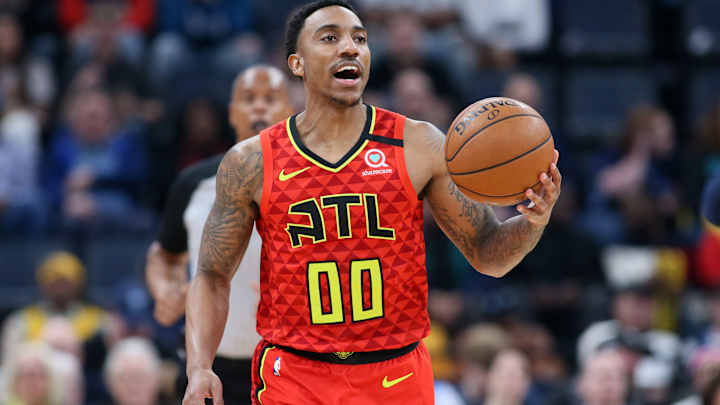2019-20 Player Review: Jeff Teague

The trade that brought Jeff Teague back to Atlanta was an acknowledgement of an offseason that went awry. After failing to stock the roster with enough ball-handlers and playmakers, the Hawks had one of the worst offenses in the NBA through the first three months of the season, largely because they had no one to guide them when Trae Young left the floor. Teauge was a capable, if unremarkable, ball-handler and distributor who could serve as a safety net for second units and mentor younger players. Teague, who says he had been hoping to return to Atlanta before his career ended, was perfectly happy to play that role and even more excited to be back in the city that helped raise him.
“I can’t be this lucky,” Teague thought. “The opportunity to just be a leader and the guys can lean on me a little bit -- I can teach, help any way I can and also try to help produce any way I can.”
Eventually, he proved quite useful on a team that needed a player like him. Watching Teague can be an underwhelming experience. He doesn’t take many shots, post huge scoring numbers, or impose his will on the game, and he has clearly lost a step or two since his younger days in Atlanta. But hiding in his meandering drives and uncomplicated passes is a degree of competence that allows his team to feel comfortable. Simply providing serviceable play behind Young allowed for significant offensive improvement from the Hawks; for that role, Teague is perfectly qualified. From January 18 to the end of the season, Atlanta was 10-15, with a league-average offense to boot. The Hawks scored 110.5 points per 100 possessions with Teague on the floor -- a middling figure they would have been thrilled to reach before Teague arrived.
Teague’s minutes, production, and efficiency all declined after he came to Atlanta, but relative to what the likes of Evan Turner, Tyrone Wallace, and Brandon Goodwin provided at backup point guard, the Hawks still benefited trading for him. He often catalyzed the offense with his passing, setting up easy shots for teammates with quick drive-and-kick bursts, but also provided his share of record scratches by passing up open shots or bringing weak drives into fierce interior defenders. Lloyd Pierce constantly urged Teague to shoot the ball more often, but the message didn’t fully break the point guard’s instinct for pump-faking and putting the ball on the floor. He attempted 10 or more shots just three times in 25 games with Atlanta, and didn’t hit multiple 3-pointers in any of them.
That must change if Teague is to retain his effectiveness moving forward. Teague has been a passable 3-point shooter for much of his career, and as his speed continues to decline, the jumper will become an increasingly important part of his game. The more hesitant he is, the less attention defenders will pay him when he doesn’t have the ball. If he remains with the Hawks moving forward, it will be crucial that he become a more willing 3-point gunner.
The Hawks acquired Teague open to the possibility of keeping him around beyond the 2020 season. They believed the 6-3 point guard could not only back up Young, but occasionally share the floor with him as a floor-spacer and secondary playmaker. “That was one of the areas going into the summer that we knew we were going to have to address,” Travis Schlenk told The Athletic when the Hawks acquired Teague. “This is a great opportunity to have a dress rehearsal and see how it goes. We are hopeful.”
On one side of the ball, that theory held up. Atlanta scored over 1.13 points per possession when its two point guards played together, with enviable shooting and turnover rates across the board. The other end of the floor, however, was a complete disaster. Opponents ran up 125.3 points per 100 possessions on that backcourt (who, in fairness, did not play with outstanding defensive personnel), scoring in essentially whatever manner they desired. That sample size only contains 407 possessions, but that pairing didn’t pass the smell test on defense, either. Teague didn’t have the luxury of playing with reliable rim protectors on bench units, but the Hawks defended poorly no matter whom he shared the floor with. Masking Young’s defensive limitations requires a guard with more defensive chops than Teague has.
Teague made $19 million last season, but the Hawks could bring him back at a far lower figure than that if they so choose. Atlanta could have more cap space than anyone else in the league this offseason, and with few proven backup point guards slated to hit free agency, retaining Teague for around $10 million annually might be a decent outcome for both sides. The Hawks will need more from Teague than what he provided last season -- meager production on below-average efficiency -- but given his track record, they have reason to expect both to improve as he grows more comfortable with the offense. Schlenk will not repeat the mistake of not signing a backup point guard. He may not yet know if Teague is the right one to keep around.

I am a basketball writer focused on both the broad concepts and finer points of the game. I've covered college and pro basketball since 2015, and after graduating from Indiana University in 2019, joined SI as an Atlanta Hawks beat writer.
Follow @bladner_